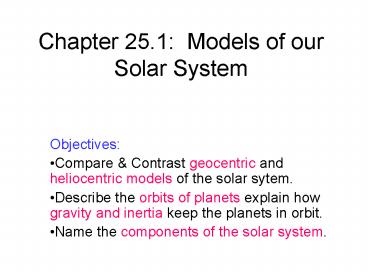Chapter 25'1: Models of our Solar System - PowerPoint PPT Presentation
1 / 15
Title:
Chapter 25'1: Models of our Solar System
Description:
... their moons (satellites),asteroids, kuiper belt objects, & comets (All orbit sun) ... Kuiper Belt Objects. Comets. A.U. (Astronomical Units) ... – PowerPoint PPT presentation
Number of Views:176
Avg rating:3.0/5.0
Title: Chapter 25'1: Models of our Solar System
1
Chapter 25.1 Models of our Solar System
- Objectives
- Compare Contrast geocentric and heliocentric
models of the solar sytem. - Describe the orbits of planets explain how
gravity and inertia keep the planets in orbit. - Name the components of the solar system.
2
Answer these questions on the top of your Guided
Reading Worksheet.
- What is the difference between the geocentric and
heliocentric models of the solar system? Which
one is accurate? - Saturn is 10 x farther from the sun than Earth.
What is the distance between Saturn and the sun
in AU? In kilometers or miles? (show your work) - The Andromeda galaxy is 2.5 million light years
away. How long does it take the light from
Andromeda to reach us ?
3
1. Models of the Solar System
- Ancient people thought
- E. is stationary Sun, planets, stars move
around E. - Observed 5 planets Mercury Venus Mars
Jupiter Saturn
4
A. Geocentric Model Earth is the center of the
universe (a sphere). Stars planets orbit E.
each day.
- Who Most ancient Greeks later Ptolemy
(Egyptian 140 AD) maps out position of planets
with this model (Accepted for 1400 yrs) - Earth is stationary.
- fixed of stars.
5
A. Geocentric Model Ptolemys Epicycles
When E. passes planets they look like they are
moving backwards relative to us for a while.
This apparent (not actual) backward motion in
known as retrograde motion. Ptolemy didnt
believe E. moved (it was the center of the
universe) so he couldnt explain this
backward motion of planets. Thats where
Epicycles come in but they are not real.
6
Problems with Geocentric Model
Geocentric model cont.
- Its WRONG! But also
- 2. Earth is not stationary (It rotates)
- 3. It could not explain the motion of planets
so Ptolemy created EPICYCLES to explain
planetary motion.(Especially RETROGRADE motion)
See Epicycles zebu.uoregon.edu/.../121/lecture-3
/ptolemy.html
7
B. Heliocentric Model Sun is the center of
universe. Earth orbits the sun.
- Aristarchus Ancient Greece Proposes theory.
Not widely accepted. - Nicolaus Copernicus 1543 AD Thinks Aristarchus
had the right idea and develops it into a
publication. - Problem w/Copernicuss Model Orbits are not
perfect circles.
- Retrograde Motion of Mars http//www.sciencemaste
r.com/space/item/helio_2.php - http//www.astro.utoronto.ca/zhu/ast210/both.html
8
B. Heliocentric Model Galileo
- Galileo 1616, 1632 Publications
- Explains how Inertia Gravity keep planets in
motion. - Finds Evidence to Support Copernicuss
Heliocentric Theory - Venus has phases (new full cant be seen b/c
sun blocks Venus must move around the sun, not
Earth). - Jupiters moons Galileo discovers 4 moons
orbiting Jupiter NOT EARTH (Earth must not be
at the center of the UNIVERSE).
http//astronomyonline.org/SolarSystem/GalileanMoo
ns.asp?CateSolarSystemSubCateJupiterSubCate2J
T02 - Reward House arrest for life.
9
2. Planetary Orbits Inertia Gravity keep
planets moving in a curved path.
- 1. INERTIA Newton 1st Law of Motion tells us
that planets want to keep moving in a straight
line forever (in motion stay in motion) - GRAVITY The Suns gravitational pull keeps
planets fr. Moving in a straight line. This
tugging creates the curved path. - Gravity is an attractional force between two
masses.
Gravity pulls on Earth
Inertia Earth want to keep moving in a straight
line (moving keep moving, in same direction).
The force that prevents this Gravitational
force from sun.
10
2. Planetary Orbits
- Johannes Kepler (1600) revises Copernicuss model
- Orbits are not circles theyre ELLIPSES (OVAL)
- Planets orbit the sun in a plane called the
- ECLIPITIC
11
3. Components of the Solar System
- Solar System Sun, planets, their moons
(satellites),asteroids, kuiper belt objects,
comets (All orbit sun)
Sun MercuryVenus EarthMarsAsteroid
BeltJupiterSaturnUranusNeptune
PlutoKuiper Belt ObjectsComets
12
3. Components of the Solar System
- A.U. (Astronomical Units)
- average distance between Earth sun (1 AU)
- 93 million miles (149.6 km)
- Used to measure distances w.in S.system
- Jupiter is 5 AU from sun its 5 x farther fr.
Sun than E.
13
A.U.s
Distances Within the Solar System
14
4. Exploring the Solar System
- Telescopes spacecraft space probes
- Manned Missions to the Moon
- July 20 1969 Apollo 11 touches down on moon
(Neil Armstrong) - Apollo 17 last mission
15
(No Transcript)





















![Observing the Solar System Chapter 14.1 [p. 538] PowerPoint PPT Presentation](https://s3.amazonaws.com/images.powershow.com/4088071.th0.jpg?_=20130802087)








